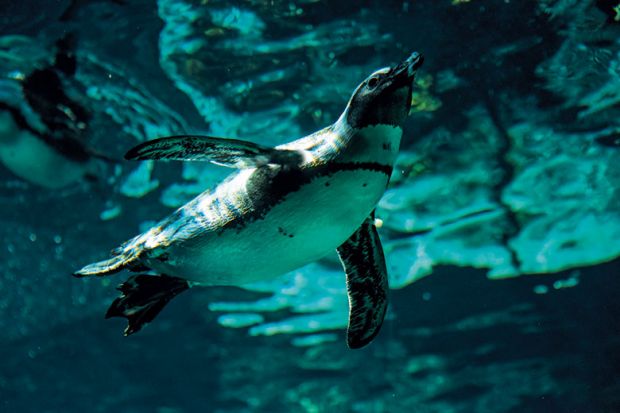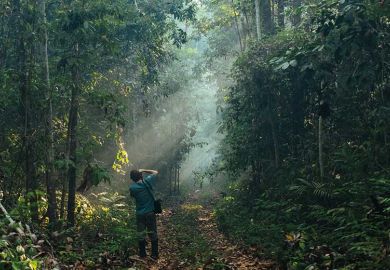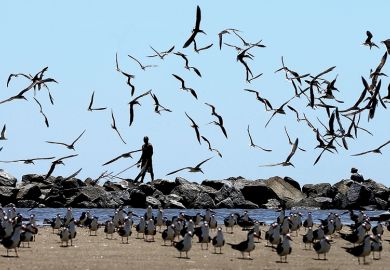Rory Wilson has always loved penguins. So much so that he even spent a year alone on an island studying them, for his PhD at the University of Cape Town in the 1980s. He hoped that his research into the foraging ecology of the African penguin would help conservationists in their efforts to save a species that, even then, was “frighteningly in danger of extinction”. Yet he soon hit a problem. While he could obviously observe the birds when they came to nest on land, how could he track their movements and behaviour at sea?
“There was no technology available,” recalls Wilson, who is now professor of aquatic biology and sustainable aquaculture at Swansea University. “I saw them jump in the water in the morning and come back after sunset and I thought: ‘How on earth are we going to figure this one out?’…I tried to scuba, but they would just not be followed by people.”
In order to obtain the data he required, Wilson therefore created a simple speed meter by cutting the end off a syringe to make a tube and inserting some stainless steel wire wound into a compression spring, with a polyurethane bung at the end. He attached a tiny bead of radioactive phosphorus to the bung and wrapped some X-ray-sensitive film around the tube. When strapped on to the penguin, the bung faced forwards so that the faster the bird swam, the more the water pressure would compress the spring. The traces left on the film by the radiation offered a crude measure of the bird’s swimming speeds and the time it spent at each speed.
This proved to be only the start of Wilson’s innovation. He has been at the forefront of developing ever more elaborate tracking devices ever since, culminating in a 2006 Rolex Award for Enterprise to fund the development of a single lightweight device suitable for monitoring multiple species in multiple ways. This “black box” – which the Natural Environment Research Council had previously declined to fund – includes a compass and a triaxial accelerometer to precisely measure movement, and a respirometer to monitor oxygen use and, therefore, energy expenditure.
But in the early days, Wilson tells Times Higher Education, he “couldn’t possibly have dreamed that one day we would be able to record every flipper beat and footstep that the penguin takes or makes, every fish that it swallows; [or be able] to resolve the sub-metre details of high-speed chases, sometimes hundreds of metres below the sea surface; and to look at the acceleration signatures of the way penguins move on land to determine just how many fish they have in their stomach and, possibly, how stressed they are!”
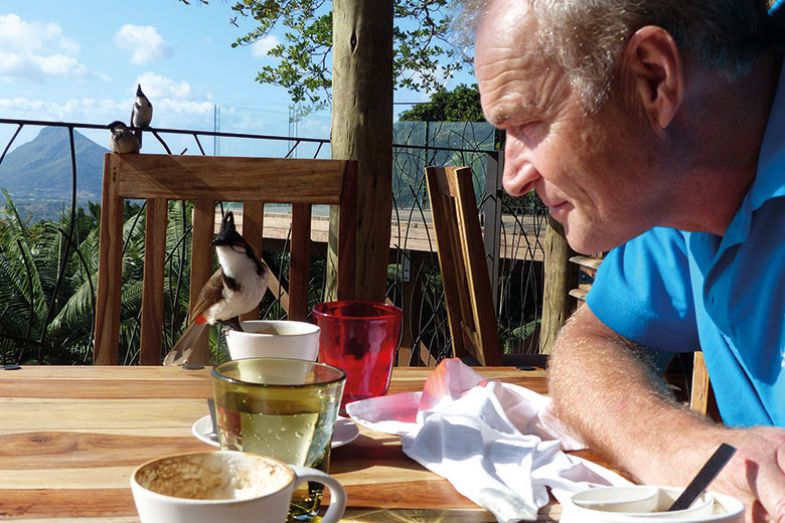
As well as developing the technology, Wilson has extended his monitoring work to other species, including albatrosses, badgers and sloths. This has faced him with some startling challenges around “how to get tagging technology on to animals that are, for example, large, fierce, dangerous or virtually impossible to catch – and how to get the data back once the animal has been tagged”.
Take the case of the endangered whale shark. These are the biggest fish in the sea, but we know very little about them. Wilson’s colleague, Brad Norman, an adjunct research fellow at the University of Western Australia, has been looking at how they react to the tourist industry at Ningaloo Reef, a world heritage site off north-western Australia. The concern, Wilson says, is that the tourists’ presence could discourage the whale sharks from remaining on the reef long enough to “fulfil their ecological necessity by feeding properly”. Hence, knowing their movements is crucial to conservation efforts.
Yet tagging them is tricky, since “a whale shark can be the size of a bus. It is not something you can pull on to a boat.” So the tagging must be done by divers: “When a spotter plane says one’s coming in your direction, you drive the boat in front of it and jump in the water. One person has a tag on a sort of spring system and, when the shark swims down, operates the spring and pops it on the dorsal fin.”
However, since these attempts are often unsuccessful, Wilson (pictured in dark trunks, below) has been enlisted as a “wingman”, diving under the shark to catch the rapidly sinking tag so that Norman can have another go. But it is the successful taggings that pose the greater dangers for a wingman: “Sometimes when you put the tags on the sharks, they give a substantial flick with their huge tails, which are just about where you are, so you can be rough-and-tumbled by them, for sure.”
Another project that Wilson has been involved in related to endangered leopards in Oman. Since capturing a wild one is a long and arduous process, the researchers decided to trial the tagging device in a zoo.
“The chap in charge of the cats had a sort of blow dart,” says Wilson, “and darted a female. She was absolutely out for the count and when he went up to her I thought: ‘Why is he so scared? She’s out, she’s dribbling, her eyes have gone roofwards.’ ”
But when he asked the keeper, the man replied “Look at this finger! Where we are standing now, I had my fingers through the grating and a completely sedated animal suddenly rushed up and stuck one of her claws in my finger and tried to pull me in.”
“She ripped open the whole of his finger,” Wilson goes on. “You cannot imagine how dangerous these animals are. As we were speaking, that same animal, from being completely prone, suddenly jumped up, spun 180 degrees and leaped towards us.”
More dangerous still is the vast South American sea lion, particularly the males guarding their harems. Since they have huge fat reserves, it is very difficult to determine the right dosage to sedate them, which means that they are particularly prone to waking up unexpectedly. This can make for some nerve-racking encounters. Wilson remembers an occasion in Argentina when “we took this gigantic male down”. The animal had “a massive head, with hideous teeth”, but sedated sea lions need to be given oxygen via a tube to their trachea, so the vet ordered the researchers to take some rope and prise its jaws open so that she could put her arm in to insert the tube. If the sedative dosage had been insufficient, “there is absolutely no doubt that she would have had her arm bitten off”. Luckily for everyone, the sea lion remained asleep.
Only slightly safer, as Wilson tells it, is a technique whereby “you creep up doing leopard crawl with an air gun” and shoot the tag at the sea lion in a sort of pellet. However, “you have to be lying flat to get a decent shot at it. If that thing comes running towards you – and they are extraordinarily fast – you have to run away along a hideously [tiring] pebble beach”.
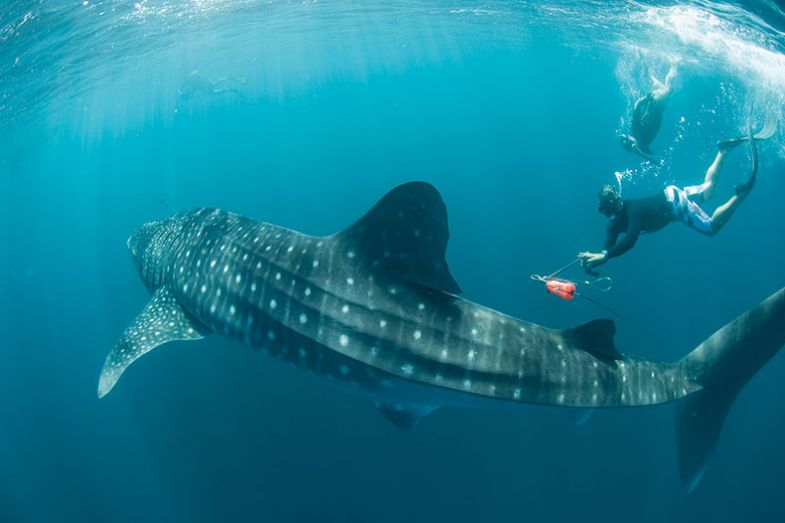
Today, reports Wilson, “bio-logging and animal tagging technology has gone exponential, with the number of publications surging higher every year”.
These have illuminated numerous aspects of animal behaviour, many of them directly relevant to conservation, and have also helped us look at animals in new ways. A 2014 paper that Wilson co-authored in Frontiers in Ecology and the Environment, for example, suggests that “ultra-sensitive movement sensors” might enable us to detect stress effects in animals and even diagnose “subclinical illnesses, such as bovine spongiform encephalopathy”, which are otherwise very difficult to spot. With tagging devices now producing seriously big data – a billion data points for four weeks’ deployment – researchers can transform the data into what Wilson calls “3D whirling imagery”, which “changes the way you think about animals. Technology translates things such as acceleration and magnetic field into patterns and swirling colours”.
It may even be possible to take the information provided by the latest tagging systems and turn it into “a model of an animal wandering over Google Earth. People could log in and zoom in and out and see the animal from all angles as it does what it did when it was wearing the tag, [a form of animation] produced by the animal itself.”
A possible downside is that making available so much detail about animal movements could help poachers. On the other hand, new sorts of tags could help to combat poaching. Wilson and his team are working on one for the world’s rarest tortoise, Madagascar’s ploughshare. “The tag is ultra-small, hidden underneath the animal and stuck to it. This tag records everything the tortoise does, and if it gets picked up or manhandled, it sends a text saying: ‘Someone is poaching me.’”
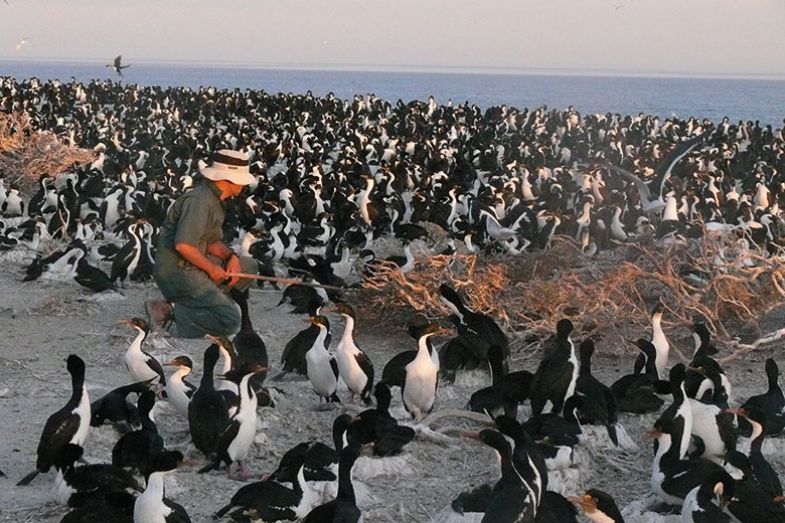
Although Wilson is now in his sixties and “would no longer want to spend 10 days on a boat for the chance of finding hammerhead sharks, or trek 10 kilometres a day up a mountain for snow leopards”, he “still love[s] to be in the field”, observing animals both familiar and new. “Every time I study a different animal I feel like a child again,” he says. “When I go out to the penguins in Argentina, I look into the nest and there’s a bird looking out and I feel to my core: ‘I know you. I understand you. You can do nothing that will surprise me.’ And then I go to a project on sloths and I wouldn’t even begin to know how to catch them.”
At the same time, deep familiarity with one species can sometimes be transferable. Back on “penguin island” in the 1980s, one of Wilson’s rare visitors was an Israeli professor, who came with a question: “This is something we’ve been working on in Tel Aviv for a few years now. We have trees a bit like a Christmas tree and the starlings come and roost in them in the evening. They all put themselves on the outside branches at the beginning, and then, in the middle of the night, all move next to the trunk. Why do you think they do that?”
Such behaviour may have perplexed the Israeli generalists, but Wilson instantly understood what it was about: since the starlings arrive at the roosts with their guts full, the safety of being close to the trunk is initially outweighed by the benefit of avoiding a perch directly below another bird’s active bowels.
“You don’t want to crapped on by the bird above you!” Wilson explained. “Anyone who works on a cliff knows that!”
Register to continue
Why register?
- Registration is free and only takes a moment
- Once registered, you can read 3 articles a month
- Sign up for our newsletter
Subscribe
Or subscribe for unlimited access to:
- Unlimited access to news, views, insights & reviews
- Digital editions
- Digital access to THE’s university and college rankings analysis
Already registered or a current subscriber?
